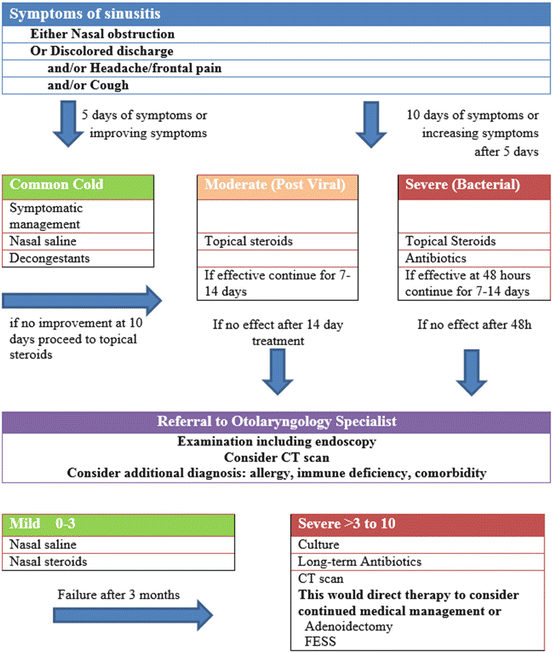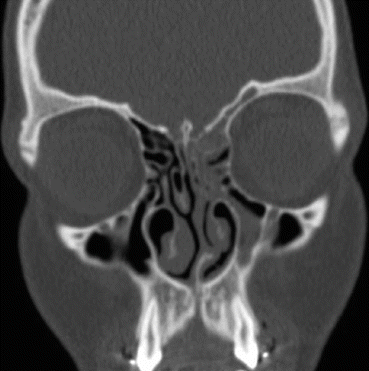EPOS 2012
AAP 2013
Acute rhinosinusitis
<12 weeks for complete resolution
Acute viral rhinosinusitis
<10 days duration of symptoms
Acute post-viral rhinosinusitis
Worsening symptoms after 5 days or persistent symptoms after 10 days
Acute bacterial rhinosinusitis
+additional symptoms of colored discharge, severe local pain, fever >38 C, elevated ESR/CRP, double sickening
>10 days of symptoms and/or worsening course and/or >3 days of severe onset, fever >39 C and purulent discharge
Subacute bacterial sinusitis
30–90 days of symptoms in which symptoms resolve completely
Recurrent acute bacterial sinusitis
Episodes lasting <30 days separated by at least 10 days with no symptoms
Chronic sinusitis
≥12 weeks without complete resolution of symptoms
>90 days of symptoms
EPOS 2012: European Position Paper on Rhinosinusitis and Nasal Polyps
In 2012, EPOS presented/published new and updated guidelines for sinusitis. The broad principles of the classification and treatment highlight the importance for the clinician to establish duration of symptoms and chronological relation of onset. Some of the important EPOS 2012 updates included adding diagnostic symptom of cough and eliminating the diagnostic symptom of reduction or loss of smell. EPOS 2012 also defines a new category for acute bacterial rhinosinusitis and subcategory for post-viral acute rhinosinusitis.
Acute rhinosinusitis is defined by the presence of two or more of the following symptoms: nasal blockage, nasal discharge, facial pain, or cough with a duration of less than 12 weeks.
Chronic rhinosinusitis in children is not as well studied as in adults. The classification is similar with two or more of the following symptoms: nasal blockage, nasal discharge, facial pain, and/or cough with a duration of greater than 12 weeks without complete resolution of symptoms. Adenoid tissue is recognized as a prominent contributor to this disease.
Acute bacterial rhinosinusitis is defined by the presence of at least three of the following symptoms: discolored unilateral and purulent secretion, severe localized pain, fever, elevated ESR/CRP, and worsening of symptoms after short improvement following viral infection.
The guidelines also use the visual analog scale to assist in diagnosis when possible, asking patient to self-assess where along a 10 cm line. The symptoms are scaled accordingly, mild for 0–3, moderate for >3–7, severe for >7–10.
AAP 2013: Clinical Practice Guidelines from the American Academy of Pediatrics
AAP defines and categorizes sinusitis according to the duration of symptoms. If the duration of symptoms persists beyond 7–10 days, the diagnosis is acute sinusitis. If the symptoms last up to 30 days but has asymptomatic intervals of 10 days in between, the diagnosis is recurrent sinusitis. Subacute sinusitis is diagnosed when symptoms last 30–90 days. Chronic sinusitis is diagnosed when symptoms persist for greater than 90 days, 6 or more recurrent exacerbations of sinusitis in 1 year, or acute exacerbations without intervals of complete resolution.
Indications for Diagnostic Nasopharyngeal Endoscopy
The use of flexible or rigid nasal endoscopy in children can be helpful in the diagnosis of sinusitis and the exclusion of nasal foreign bodies or polyposis as a potential cause of sinusitis. The benefits of this invasive examination must be weighed against the possible risks given the age and cooperativeness of the pediatric patient.
Diagnostic Imaging
Plain films have little diagnostic value for evaluation of rhinosinusitis and should not be routinely used. Computed tomography (CT) with contrast or magnetic resonance imaging (MRI) with contrast in children should be considered for signs of acute complicated rhinosinusitis. Concern for orbital extension with proptosis, reduced or painful eye movement (ophthalmoplegia), decreased visual acuity (initially manifesting itself with reduced green/red color discrimination), or lethargy should prompt an urgent CT scan with contrast. MRI may be used when concerns of intracranial extension of disease are present, such as with intracranial cerebritis, abscess, or cavernous sinus thrombosis.
An additional update in AAP 2013 is that there is no indication for imaging for uncomplicated acute bacterial sinusitis. The basis of this recommendation is that there can be abnormalities seen on imaging studies in normal healthy children such as mucosal thickening or sinus opacification that could falsely lead to the diagnosis of acute bacterial sinusitis [16].
Laboratory Investigations
Children with chronic rhinosinusitis should be judiciously tested for contributing underlying conditions such as asthma, cystic fibrosis, and immunodeficiency.
Treatment
The two classification schemes each contain subtle differences in their recommendations and treatment algorithms. The specific recommendations are highlighted below, the theme of each highlight the importance to establish the diagnosis of acute sinusitis, attempt medical management and address any underlying pathology, and proceed to surgery if the infection is refractory to aggressive management or when complications are imminent or present.
Medical Management
EPOS 2012
The recommendations for treatment will vary depending on the time course and severity of the symptoms as discussed previously. According to EPOS, there is evidence that antibiotics and topical steroids are useful in the treatment of rhinosinusitis; the selection of monotherapy or combination therapy is based on the presumptive diagnosis and the severity of the disease.
The presumptive diagnosis of viral upper respiratory infection is made if symptoms have been present for 5 days or are remitting at that time, for which purely symptomatic treatment with nasal saline and decongestants is recommended. If symptoms have persisted for 10 days or are worsening after 5 days, the working diagnosis is post-viral sinusitis or acute bacterial rhinosinusitis. Based on the severity of symptoms, the recommendation is to initiate only topical nasal steroids for moderate symptoms and both topical steroids with antibiotics for severe symptoms. If patient improves after 48 h, the recommendation is to complete a treatment course of 7–14 days. If a patient fails to improve despite initial medical management, the recommendation is referral to an otolaryngologist (see Fig. 9.1).


Fig. 9.1
EPOS 2012 guidelines
The recommendations for antibiotics are based on studies where a clinical diagnosis of acute bacterial rhinosinusitis was made according to the criteria previously discussed. One recent randomized, placebo-controlled trial evaluated the efficacy of amoxicillin (90 mg/kg) with potassium clavulanate (6.4 mg/kg) or placebo in children 1–10 years of age with a clinical presentation compatible with bacterial ARS (persistent symptoms, acutely worsening symptoms, or severe symptoms) [17]. Symptom scores were obtained at multiple time points, and the children were evaluated at day 14 from onset of treatment and their condition rated as cured, improved, or failed. Twenty-eight patients in each group completed the study, and their average age was around 5 years. Children receiving the antibiotic were more likely to be cured (50 % vs. 14 %, p = 0.01) and less likely to experience treatment failure (14 % vs. 68 %, p < 0.001) than children receiving placebo.
AAP 2013
The most significant areas of change from the 2001 guidelines are the addition of a clinical presentation designated as “worsening course,” inclusion of new data on the effectiveness of antibiotics in children with acute sinusitis, and a review of evidence indicating that imaging is not necessary to identify those children who will benefit from antimicrobial therapy [4].
Antibiotic therapy is indicated in acute sinusitis when symptoms are severe or persistent or if a child appears toxic. The guidelines suggest treatment for 10–14 days or for 1 week beyond symptom resolution.
For patients with chronic sinusitis, the guidelines indicate a prolonged 4-week treatment with a broad-spectrum beta-lactamase-resistant second-line antibiotic. If there is no clinical response after 1 week of treatment, changing the antibiotic should be considered. Cultures may also be considered at the time of initiation to direct therapy.
The guidelines make no recommendations on adjuvant treatments including saline irrigation, nasal steroids, decongestants, and mucolytic therapy citing inadequate evidence. Smaller studies have demonstrated saline sinus irrigation with efficacy in the treatment of acute and chronic sinusitis. The authors propose irrigation increases mucociliary flow, vasoconstriction, mechanically clears secretions, decreases bacterial counts, and clears allergens and environmental irritants from the nose [18, 19]. Cochrane reviews published on the use of saline irrigation in acute sinusitis in adults in 2010 and concluded that the trials were too small or too biased to be confident on benefits [20]. Intranasal steroids compared to placebo in children were shown to have modest reduction in symptoms although there are criticisms of the methodology for these studies [21]. There are several studies in acute sinusitis in adults which provide data supporting the use of intranasal steroid as either monotherapy or adjuvant therapy to antibiotics [22].
Antimicrobial Selection
The AAP Subcommittee of Sinusitis and Committee on Quality Improvement recommended amoxicillin as first-line therapy for children younger than 2 years of age suspected of having acute bacterial sinusitis of mild to moderate severity who do not attend daycare and who have not been treated recently with an antimicrobial agent. They recommend an amoxicillin dose of either 45 mg/kg/day in two divided doses or 90 mg/kg/day in two divided doses. The AAP committees further recommended that children who did not improve while receiving the lower amoxicillin dose, children with more severe illness, and children who attend daycare should be treated with high-dose amoxicillin-clavulanate 80–90 mg/kg/day of amoxicillin component in two divided doses [23].
Indications for Surgery
In pediatric rhinosinusitis, there is a significant overlap between adenoiditis and rhinosinusitis. In the setting of chronic sinus disease with adenoiditis, adenoidectomy resolves symptoms in 50 % of patients. A meta-analysis looking at the benefit of adenoidectomy alone in the treatment of children with CRS included nine studies that met the inclusion criteria. All studies showed that sinusitis symptoms or outcomes improved in half or more patients after adenoidectomy. Eight of nine studies were sufficiently similar to undergo meta-analysis, and in these, the summary estimate of the proportion of patients who significantly improved after adenoidectomy was 69.3 % [24]. Ramadan and Tiu reported on the refractory cases after adenoidectomy, reporting children younger than 7 years of age and those with asthma were more likely to fail after adenoidectomy and go on to require salvage functional endoscopic sinus surgery (FESS) [25].
In absence of adenoiditis or refractory sinus disease, FESS may be indicated to target uncinate removal, anterior ethmoidectomy, and maxillary antrostomy (see Fig. 9.2). A meta-analysis looking at outcomes of FESS in the pediatric population has shown that surgery is effective in reducing symptoms with an 88 % success rate and a low complication rate [26].


Fig. 9.2
Non-contrast coronal CT of an 11-year-old female undergoing FESS for symptomatic chronic unilateral rhinosinusitis. Note septal deviation and ipsilateral hypoplastic maxillary sinus
Image-guided surgery can be safely utilized in children with chronic rhinosinusitis, in those undergoing revision surgeries, and in any patient in whom the anatomy may be distorted, without increasing the rate of intraoperative complications [27]. The indications for image-guided surgery include patients with any distorted sinus anatomy; those with extensive sinonasal polyposis, pathologic processes in the frontal, posterior ethmoidal, or sphenoidal sinuses; and patients undergoing skull base surgery [28].
Concurrent Symptoms and Medical Conditions
Allergic Rhinitis
Allergic inflammation leads to nasal congestion and swelling of the mucous membrane, which may obstruct or impede normal sinus drainage. Subsequent inflammatory responses in the epithelium lead to an influx of granulocytes, with swelling and pain from the mucosa and thickened secretions. In children evidence of allergic rhinitis has been found in 36–60 % of patients with chronic rhinosinusitis [29–31].
Symptoms that can be associated with allergic rhinitis include sneezing, itching (of nose, eyes, ears, palate), rhinorrhea, postnasal drip, congestion, anosmia, headache, earache, tearing, red eyes, eye swelling, fatigue, drowsiness, and malaise [32].
The most commonly used methods of determining allergy to a particular substance are allergy skin testing (testing for immediate hypersensitivity reactions) and in vitro diagnostic tests, such as the radioallergosorbent test (RAST), which indirectly measures the quantity of antigen-specific IgE.
Stay updated, free articles. Join our Telegram channel

Full access? Get Clinical Tree






